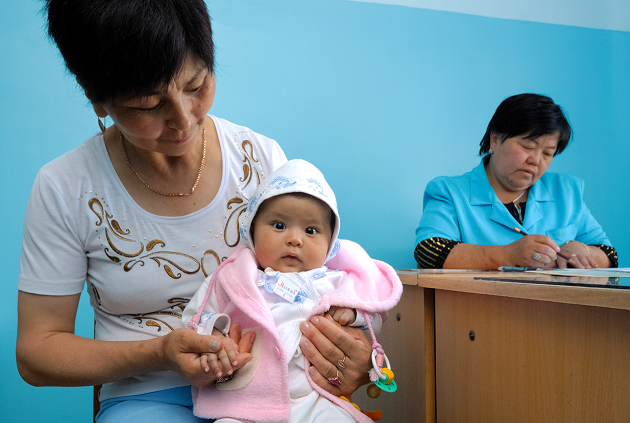Key Points
Between 1997 and 2014, the number of stunted children in the Kyrgyz Republic declined from above 200,000 to just 95,000, despite an increase of almost one third in the size of the under-five age cohort.
A rapid decrease in poverty facilitated big gains in food security and maternal nutritional status and care, which drove the stunting reduction.
The Kyrgyz Republic completely restructured its health system to provide universal basic services to all, especially maternal, newborn, and child care.

Collapse, independence, and emergence from crisis
Between 1997 and 2014, the number of stunted children in the Kyrgyz Republic declined from above 200,000 to 95,000, despite an increase of almost one third in the size of the under five age cohort. Stunting prevalence declined very rapidly in the first half of this period, from 36 percent in 1997 to 18 percent in 2006, and more gradually thereafter, dropping another five percentage points by 2014.
Unfortunately, stunting data does not exist prior to 1997, so it is difficult to put the Kyrgyz Republic’s epidemic into historical perspective. We can, however, make inferences. After the Soviet Union collapsed and the Kyrgyz Republic became independent in 1991, the country plunged into a debilitating economic crisis that lasted for the rest of the decade. It is possible that the years around 1997, the first year in which every child under five was born after the collapse, marked a nadir. At the very least, it is reasonable to conclude that stunting spiked in the immediate post-Soviet era - and that this spike was reflected in the 1997 stunting rate.
By the turn of the millennium, the Kyrgyz Republic had started to emerge from the crisis, building a relatively stable and equitable economy based on family farms and restructuring its health system.
In our analysis, one of the biggest factors in the Kyrgyz Republic’s success against stunting was the rapid decline in poverty in the country after 2000. But poverty reduction does not always or automatically lead to improvements in children’s height-for-age. In the Kyrgyz Republic, due in large part to strategic policymaking, the rise in household incomes facilitated big gains in food security and maternal nutritional status and care. Those gains, in turn, drove the halving of stunting in a period of less than a decade.
Key lessons from the Kyrgyz Republic include:
- Growth of agriculture: When properly supported, an agriculture sector oriented around family farms can drive stunting declines by two separate modalities: increasing food security and reducing poverty.
- Targeted social protection: Even small amounts of money can create a strong safety net if cash transfers are targeted effectively at the most vulnerable populations in society.
- Right-sizing of primary care: For low-income countries, focusing on accessible systems that provide universal basic services helps address stunting.
- Adoption of breastfeeding practices: Investing resources into breastfeeding advocacy and promotion can result in a significant improvement to the growth trajectory of children between birth and six months of age.
- Donor coordination and shared prioritization: Engaging donors through a comprehensive planning process provides an opportunity to institute lasting reforms while avoiding duplication of work and gaps in design. As an example, health reforms in the Kyrgyz Republic were based on such a planning process.
